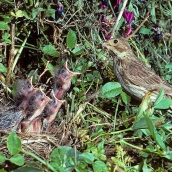Corn Bunting (Emberiza calandra)
This passerine measures 16-19 cm in total length. It is identified by a thick robust bill and cryptic plumage, greyish-brown on the back and much lighter on the belly, with vertical streaks; the tail is relatively long. Its presence is given away by its peculiar metallic song. Distribution is widespread and encompasses central and southern Europe, North Africa, the Middle East and Asia to Kazakhstan and northwest China. The species is also found throughout the Canary Islands, with occasional sightings on the islets of Alegranza and La Graciosa. It favours open country covered in low-lying vegetation and shrub, including fields of grains and pulses, and pastureland. However, it is also found on stony plains of xerophytic vegetation, grasslands and similar environments. In Tenerife, for example, it can be seen up to 1,500 m above sea level, but most populations are found from 800-1,000 m, at the lower edges of forests. Its diet is mainly composed of seeds, but in the breeding season, it often hunts invertebrates (e.g., grasshoppers) to eat and to feed its chicks. It nests on the ground, among grasses or under the shelter of a small bush, and lays a clutch of 4-6 eggs. The breeding season is from March to June, but can be as early as January-February in the eastern islands, particularly in years of high rainfall. It gathers in large flocks of 50-70 individuals, sometimes more, and can join forces with other granivorous birds, such as the linnet (Carduelis cannabina). In the summer months it virtually disappears from Lanzarote and Fuerteventura, while in the central and western islands, it moves from drier to wetter areas. From October on, its birdsong heralds its return. Currently, populations in the Canaries are in evident decline, a common occurrence in many countries of Europe. It is extinct in La Palma and very rare in Lanzarote, while in Tenerife it is only relatively common very locally. Diminishing flock size is a clear indicator of such rarefaction, and the species has gradually disappeared from areas where it was present up until the 1990s. Threats to these birds include changes in types of crop, the disappearance or significant reduction in cereal growing, chemical products used in agriculture, removal of vegetation during the breeding season, predation by introduced mammals (cats and rats) and roadkill.













